Juvenile Ngwino Succumbs to Snare Wounds
By Gorilla Doctors Staff on Monday, July 30th, 2012 in Blog.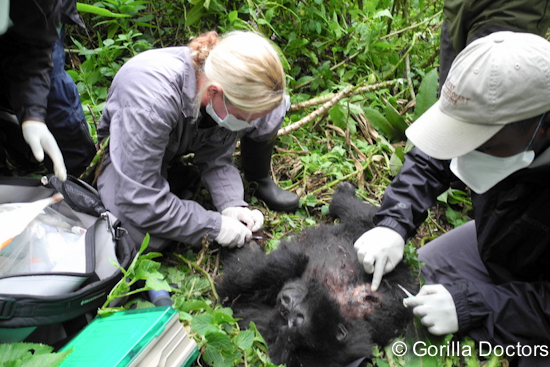 Drs. Dawn and Noel with Ngwino.This month, the Gorilla Doctors clinically managed the complicated case of Ngwino, a juvenile gorilla from Inshuti group in Rwanda who was found caught in a snare in early July. Normally, the Gorilla Doctors intervene to treat a snare-wounded gorilla the very next morning after the wound is first observed, but this time, silverback Inshuti prevented trackers and our veterinarians from approaching the infant, and then engaged another silverback in battle. Somewhere in the melee, Ngwino disappeared. More than a week later, Ngwino finally reunited with her mother and Inshuti, but still had the snare around her ankle. On July 13, Gorilla Doctors and Karisoke Research Center trekked to the group to intervene, but unfortunately found Ngwino suffering from severe injuries that ultimately proved fatal.
Drs. Dawn and Noel with Ngwino.This month, the Gorilla Doctors clinically managed the complicated case of Ngwino, a juvenile gorilla from Inshuti group in Rwanda who was found caught in a snare in early July. Normally, the Gorilla Doctors intervene to treat a snare-wounded gorilla the very next morning after the wound is first observed, but this time, silverback Inshuti prevented trackers and our veterinarians from approaching the infant, and then engaged another silverback in battle. Somewhere in the melee, Ngwino disappeared. More than a week later, Ngwino finally reunited with her mother and Inshuti, but still had the snare around her ankle. On July 13, Gorilla Doctors and Karisoke Research Center trekked to the group to intervene, but unfortunately found Ngwino suffering from severe injuries that ultimately proved fatal.
Dr. Dawn recounts what happened:
On July 13, a team including myself, Drs. Eddy and Noel, Elisabeth Nyirakaragire from RDB, Karisoke Research Center Director Felix Ndagijimana, and several trackers trekked to find Inshuti group in order to perform an intervention on juvenile female Ngwino. When we found the group, it was difficult to approach Ngwino as the silverback Inshuti was guarding her. However, we were able to visually confirm the presence of the rope snare still around her left ankle and damage to the tissue of the left foot. Based on our visual assessment, it was clear an intervention was needed to remove the snare and hopefully save her foot. Due to Inshuti’s aggressive behaviour and unpredictability, he would need to be immobilized in order to anesthetize Ngwino.
Inshuti was darted at 11:09 a.m., and fully anesthetized 10 minutes later. While Dr. Eddy and I performed a thorough physical exam on Inshuti, Dr. Noel and the trackers looked for Ngwino who was found approximately 30 minutes later, was separated from her mother Shangaza, and was darted intramuscularly at 11:43 a.m.. She was down by 11:48 a.m.
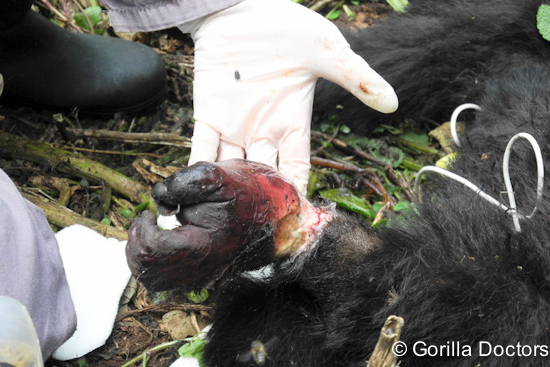 The injured leg.Once we were able to physically examine Ngwino, the devastating scope of her injuries became clear. The rope snare was so tight around her left ankle that it was cutting into the skin and subcutaneous tissues. Her entire left foot was necrotic and cold to the touch, gangrenous from losing blood supply and essentially “dead.” We might have considered amputating the foot if it were not for an even more serious shoulder wound.
The injured leg.Once we were able to physically examine Ngwino, the devastating scope of her injuries became clear. The rope snare was so tight around her left ankle that it was cutting into the skin and subcutaneous tissues. Her entire left foot was necrotic and cold to the touch, gangrenous from losing blood supply and essentially “dead.” We might have considered amputating the foot if it were not for an even more serious shoulder wound.
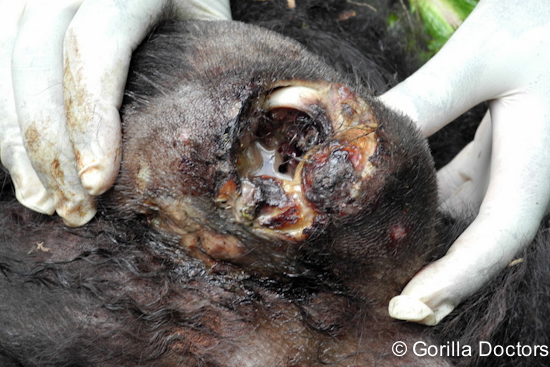 The injured shoulder.An open humeral fracture of Ngwino’s right shoulder had become severely infected with exposed necrotic bone and soft tissue, an open joint capsule, and gross purulent infection resulting in a foul smell characteristic of dead tissue. We do not know how Ngwino sustained this injury but the trackers suspected Inshuti may have tried to free Ngwino when she was first caught in the snare, wrenching her body away from the tree where the rope was tied. Due to the stage of tissue death, the infection had likely spread systemically and she had become septic. In addition, Ngwino’s body showed signs of dehydration and mild to moderate muscle wasting, and her lungs crackled under auscultation indicating a possible pneumonia.
The injured shoulder.An open humeral fracture of Ngwino’s right shoulder had become severely infected with exposed necrotic bone and soft tissue, an open joint capsule, and gross purulent infection resulting in a foul smell characteristic of dead tissue. We do not know how Ngwino sustained this injury but the trackers suspected Inshuti may have tried to free Ngwino when she was first caught in the snare, wrenching her body away from the tree where the rope was tied. Due to the stage of tissue death, the infection had likely spread systemically and she had become septic. In addition, Ngwino’s body showed signs of dehydration and mild to moderate muscle wasting, and her lungs crackled under auscultation indicating a possible pneumonia.
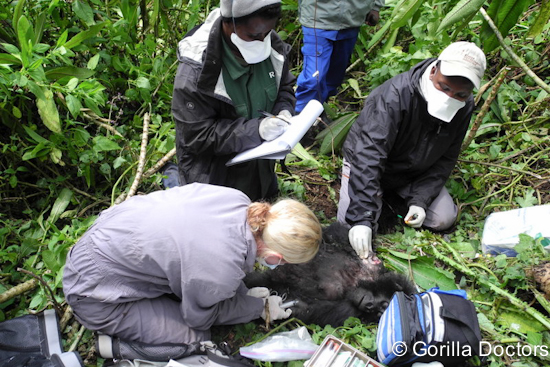 Treating Nwingo’s woundsThe severity of Ngwino’s injuries and the advanced stage of the necrosis and infection put her in a grave situation. We believed that the infected shoulder wound would result in her death if not amputated. However, such a high amputation had never before performed on a wild mountain gorilla; we have previously only amputated to the elbow. In addition, the loss of the right arm and the contralateral foot would mean that Ngwino would likely not be able to keep up with the group, feed efficiently, reproduce successfully, or defend herself in the future. She would have a poor quality of life should she be able to survive. Therefore, after discussing the options with park authorities, the decision was made to treat Ngwino as best we could without performing any amputations. Though her prognosis was grave, euthanasia was not opted.
Treating Nwingo’s woundsThe severity of Ngwino’s injuries and the advanced stage of the necrosis and infection put her in a grave situation. We believed that the infected shoulder wound would result in her death if not amputated. However, such a high amputation had never before performed on a wild mountain gorilla; we have previously only amputated to the elbow. In addition, the loss of the right arm and the contralateral foot would mean that Ngwino would likely not be able to keep up with the group, feed efficiently, reproduce successfully, or defend herself in the future. She would have a poor quality of life should she be able to survive. Therefore, after discussing the options with park authorities, the decision was made to treat Ngwino as best we could without performing any amputations. Though her prognosis was grave, euthanasia was not opted.
The wounds were flushed copiously with a povidone iodine solution, We were not able to debride much of the infected or necrotic tissue since little could be accomplished without removing the necrotic bone and while still maintaining the limbs. Injectable and topical antibiotics were administered, as were fluids and painkillers.
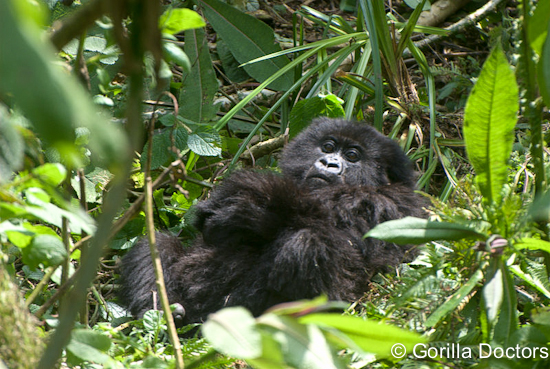 Ngwino awakens from anaesthesia While Inshuti was waking up, we injected Ngwino with a reversal and placed her near Inshuti to recover. To avoid aggravating Inshuti we quickly moved from the area, but trackers remained nearby and reported just awhile later that Ngwino was reunited with her mother and was able to suckle. However, we were not optimistic about her chances for survival.
Ngwino awakens from anaesthesia While Inshuti was waking up, we injected Ngwino with a reversal and placed her near Inshuti to recover. To avoid aggravating Inshuti we quickly moved from the area, but trackers remained nearby and reported just awhile later that Ngwino was reunited with her mother and was able to suckle. However, we were not optimistic about her chances for survival.
The next day, Karisoke Research Center trackers found Ngwino had moved very little from the recovery site and was very weak. Inshuti and Shangaza remained by her side. The next day, trackers found her deceased body. They wrapped her in blankets and brought her down to the Gorilla Doctors’ laboratory for a post mortem exam.
Ngwino is the second gorilla this year to die after being caught in a snare. In February, a Karisoke anti-poaching team found the body of an infant gorilla from an unhabituated group whose deceased body was found still ensnared to a tree.
While the number of snares found by Karisoke’s anti-poaching team has not reportedly increased, we wonder if the gorillas are perhaps frequenting areas more often used by poachers, or areas less often patrolled. Inshuti’s other infant, Akaruso, was also thought to have been caught in a snare around the same time as Ngwino, as a chewed-through rope snare was found in the group’s area concomitantly to Akaruso not using his arm well. Subsequent to an interaction with Giraneza group, Akaruso went missing and has not been seen since July 10.
Just days after Ngwino’s death, Karisoke discovered a blackback and two juveniles from Kuryama group dissembling two snares. Although adult gorillas, mostly silverbacks, have been known to recognize and dissemble snares, this is the first time Karisoke has witnessed juveniles doing so. Such an event is encouraging in light of Ngwino’s death, although we hope for a future when no gorilla has to worry about snares.
You can follow the Gorilla Doctors health monitoring efforts on our Facebook page, where we post photos and notes from our monthly visits.
Please consider supporting MGVP by making a secure online donation. Every dollar you give goes to directly supporting our gorilla health programs and One Health initiative. Thank you for your generosity.


 Donate
Donate